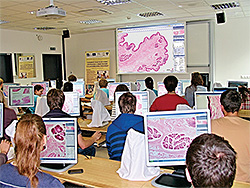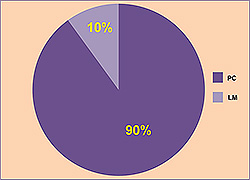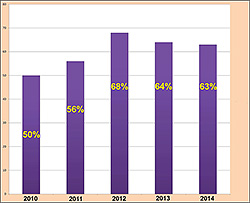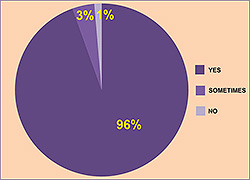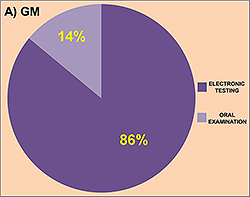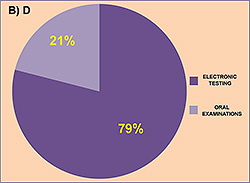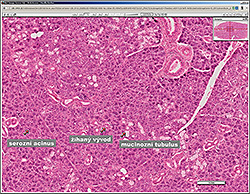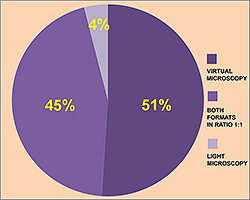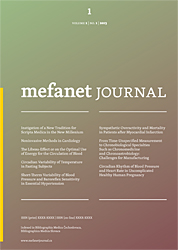
MEFANET Journal 2015; 3(2): 48-53
ORIGINAL ARTICLE
Our experience with e-learning method of teaching practical histology
Radka Lichnovská*, Drahomíra Krajčí, Běla Erdösová, Dimitrolos Krajčí
Department of Histology and Embryology, Faculty of Medicine and Dentistry, Palacký University, Olomouc, Czech Republic
* Corresponding author: radka.lichnovska@upol.cz
Abstract
Article history:
Received 25 May 2015
Revised 27 August 2015
Accepted 23 November 2015
Available online 16 December 2015
Peer review:
Michal Jurajda, Martin Komenda
Download PDF
Five years ago, the system of practical teaching at our Department of Histology and Embryology in Olomouc underwent major innovation by using e-learning format in the delivery of high-quality histology virtual slides (VS) and subject-related supporting documents observed on a PC. We have developed our own system of application of virtual slides in a classroom equipped with PC technology. In this communication, we are evaluating the impact of this method on our pedagogic effort from a teacher’s and students´ points of view.
Keywords
Histology; virtual microscopy; computer-assisted learning; e-learning format; assessment
Introduction
Histology is one of the basic morphological courses at medical faculties. Observation of images is a crucial method for understanding how tissues, as well as organs, are organized and function. A traditional light microscopy and glass histology slides were essential study tools of practical histology in the past. In the last decade, advances in computer technologies allowed a “quiet revolution” in learning and teaching, as well as diagnostic assessment in morphological disciplines such as histology and pathology [1]. Implementation of virtual microscopy (VM) constitutes an effective tool in new approaches and efficient ways in innovative teaching sessions at morphological departments. Curriculum using the virtual microscopy has been developed at several universities and the application of virtual technology has expanding tendency in education systems throughout the world [2–13].
Figure 1. Histology practical session with virtual slides. Students follow demonstration of laryngeal structures projected on the screen in this classroom and observe the identical slide on the monitor of their client PC stations
Figure 2. Majority of medical students prefers PC technology delivering virtual slides over the conventional use of light microscopes (LM)
Figure 3. Increasing positive tendency was mentioned in the students' use of supporting documents during the long-term application of e-learning format of histology practicals
Figure 4. Almost all students (96%) download supporting text and figure materials for later self-revisions
Figure 5. The majority of students from both study programmes, General Medicine (GM) and Dentistry (D) preferred electronic forms of examinations over oral ones
Figure 6. Virtual slides are freely available in an open access database Olympus NIS SQL. In this website VS are accompanied by short annotations locating and describing the main histology structures (arrows)
Figure 7. From the student's point of view, virtual microscopy was preferred to conventional optical observation. Half of students favoured virtual slide observation only, less than half supported the use of both formats, virtual and classical microscopies
Methods
The virtual microscopy system allows conversion of classical glass histology slides into digital images characterized by high resolution. Glass histology sections were scanned by means of the Olympus dotSlide system [14] to create thousands of overlapping images saved in a multi-resolution file format (vsi).
Files of VS can be quite large (up to gigabytes). Nevertheless, VS are easy to open and quick to reload when changing the field of observation or magnification. The delay in loading and magnifying virtual slides on the client PC is negligible and multiple supporting files open quickly and can be used continually during the study. The resulting images can be colour-, contrast-, and brightness-corrected to further improve the quality of faded stains in sections.
The scanning of glass slides was done with a standard 40x objective lens. Using Olyvia viewer (Olympus) the images can be viewed on local PC or in the web browser as a single image map with variable magnifications [15].
Our classroom dedicated to histology practical sessions is equipped with 1 server PC (teacher) and 30 students' PCs (clients) (Figure 1). This system is locally networked with limited, password protected connection to the faculty intranet. The server is a standard Microtower PC (Processor Intel® Core™ 2 Duo E8400, 3.00 GHz, 2x2 GB RAM, L2 6 MB cache) running on MS Server 2003 Standard Edition. The student's PC (client) is an ultra-slim unit (Processor Intel® DualCore™ E6500, 2.90 GHz, 2x2 GB RAM) running on windows XP, SP3 operating system. The core of our virtual slide learning system is our own Database of Histology Practical designated in MS Excel format. Our database is available in two language versions, Czech and English. VS are arranged into 24 sessions that systematically follow the syllabus of histology topics focused on general and special histology. The student's PC have Administrator, Lector, Student and Exam accounts set up. Students can assess only the last two accounts without any login password. The last two accounts have limited users' rights preventing any modification or delete any of the study documents. Further technical data on the setup of our practical room network are available in Krajčí et al. 2011 [16].
For electronic testing of student's practical knowledge, we have prepared quizzes using Articulate Quizmaker 13 software [17] which is simple and easy to use by teachers having no programming skills. This software has a selective option to shuffle sequences of questions and also to shuffle all distracters in the quiz randomly on monitors of student's PCs so that only one version of the quiz is enough to prepare for one practical class. The time limit for display of each question and a total time allowed for a complete test were also settable.
“Histology and Embryology” is a theoretical subject taught in two semesters in both General Medicine and Dentistry programmes. During long-term application (years 2010–2014) of our new digital format of practical teaching histology we have questioned students from both General Medicine (794 respondents) and Dentistry (405 respondents) study programmes to evaluate the impact of this new didactic format as seen from students' points of view. We have also evaluated teacher’s attitude to this innovative teaching process.
Results
After logging into a welcome desktop screen, students are hyperlinked into the content page of the histology practical database. In each session, a set of the virtual slides is completed with information on slide properties, keywords, file size, and also overview images of virtual slides. Additional supporting documents in .pdf and .ppsx formats are also available for each of the histology topics.
When we introduced our own e-learning system based on virtual slides (in 2010), we asked second-year students of General Medicine and Dentistry, who passed this new model of practical histology for the first time, to evaluate the digital format of practical sessions by means of anonymous questionnaires (the setup of the questionnaire and results are discussed in [18]). The majority of students in both specializations evaluated the use of virtual slides positively and appreciated the benefits of the new digital form of practical histology sessions (the study of histology structures in VS, the work with supplementary documents). Preliminary results of the evaluation are available in Pospisilova et al. [19]. The positive trend in acceptance of VM by students was evident also in following year evaluations. Based on students' responses, our digital-learning format brought several benefits to our teaching practice. During last five years majority of students (90%) in General Medicine and in Dentistry study programs (Figure 2) readily accepted the use of computers for observation of VS. The young population of students represents a computer-trained generation that is in compliance with new modern PC technologies.
The increasingly positive tendency was also found in the students' use of supporting documents attached to the e-learning system (from 50% to more than 60% during the years 2012–2014, Figure 3). More than half of students claimed that they benefited from using the supporting documents (slide guides, .ppt presentations, and electron microscopy images) during each practical session and almost all students (96%) download these didactic materials to their external media for later self-revisions (Figure 4). The new digital format using virtual slides and supporting materials was well accepted by teachers as well. Teachers benefited from a uniform high quality of presented virtual slides and also from more flexible personal communication with students in the class when individual guidance and explanation were needed at the student's monitor. This feature improves communication between students and teachers and improves their mutual understanding.
Students from both study programmes, General Medicine (GM) (Figure 5A) and Dentistry (D) (Figure 5B) also admitted that they benefited from the in-course electronic testing that motivated students to more systematic individual study. They unequivocally preferred electronic forms of examinations over oral ones.
There were also some drawbacks recognized during the hours of histology practicals, like a tendency of some students to passively follow the demonstration of digital slides. This should be minimized by the proper interactive engagement of students in the practical histology session. Using the screen printing function of the Olyvia viewer, students create their own presentations. They are able to screen-copy to a clipboard selected areas of virtual slides and paste them directly into their own-created .pptx presentation that are useful for later revisions.
Simultaneously, students watch projected virtual slides by means of the overhead projector on a wide screen accompanied by a teacher's explanation. (Figure 1).
Access to virtual slides at any time, not only during scheduled practical sessions, is provided through the external login (intranet, internet, multiple browsers) to the database of virtual slides (Olympus, NIS-SQL) which correspond to those in practical sessions (Figure 6) [20]. The open-access database contains short annotations of typical histology structures that are essential for identification of slides. Unlimited access to the database allows students to revise histology structures themselves.
In traditionally-oriented histology teacher’s opinion, the drawback of virtual microscopy could be the limited experience with practical handling of light microscopes in practical sessions. From our point of view, the inclusion of classical histology observing methods using light microscopes depends on the organization of teaching lessons. We do not underestimate the importance of classical microscopy in the didactic procedure. Our students also have the possibility to use light microscopes during or at the end of their regular histology sessions. Classical binocular light microscopes are available for each student in the class to revise and compare both image qualities of histology structures.
In order to follow up the student’s performance in other preclinical subjects and to receive their comparative evaluation of the digital learning method, we questioned students of 3rd year of the General Medicine Programme (136 respondents) who already had passed the Histology course with PC-based practices and at that time were currently attending histopathology practical sessions conducted in the classical format of a glass slide presentation. Although 46% of responding students experienced some discomfort when they switched to a fully manual examination of glass slides in pathology, most of them (90%) still preferred observing the virtual slides on PC monitors over the observation of glass slides. In the same attending group, 51% of students preferred virtual microscopy, 45% supported a mixed observation of virtual and glass slides, and only 4% of respondents preferred the conventional microscope observation method (Figure 7).
Discussion
Digital-learning format enabled us to introduce new models of practical teaching histology. At the Faculty of Medicine and Dentistry in Olomouc, the new digital format using virtual slides and supporting study materials represents a fundamental innovation in didactic principles of classical morphology sciences. From our point of view, the main preconditions that enabled the switch from classical light microscopes to virtual microscopy include a technical and software support, extensive collection of classical glass slides, “PC help care” performed by IT specialists available during practical sessions and enthusiasm of teachers who are open to new didactic strategies.
Recent findings based on the long-term evaluation of computer-assisted teaching histology follow and extend our previous already published data presented in MEFANET reports 04 a 05 [16,21].
According to the long-term experience, our system runs faultlessly and it is easy to be used by students and teaching staff.
Students considered virtual microscopy system comfortable and more efficient tool for study. Students also appreciated the better resolution and better image quality of virtual slides compared with conventional microscopes. This is the main statement highlighted also in other studies dealing with the application of VM [3,7,8,10,12,22,23]. The uniform set of virtual slides of the same quality was used for all students and they benefited from high-quality scans of histology slides available equally to all students in the class. They allowed them to study and discuss various details of cellular and tissue arrangements clearly at various magnifications.
When using the virtual slides, the classical glass slides no longer need to be stored in hundreds of sections, and also some rare samples or slides prepared with special staining and expensive methods can now be safely presented to students. Digital slides prevent loss or breakage of this valuable teaching material.
Student's self-created .pptx presentations with details of already observed VS and text legends fully substituted the hand-drawn and written notes used in earlier years during practical sessions. The active participation in creation of own presentations increases student's interest and attention during sessions and, on the other hand, this didactic method provides a good tool for teachers for their concurrent control of a student's activity in large groups.
Despite the engagement of teachers during practical sessions, implementation of E-learning format based on digital technology requires supplementary documentation such as precise description and annotations of VS that is essential for later self-study and revision. Students greatly appreciate the unlimited access to the online NIS-SQL database of annotated virtual slides [20], which correspond to those in practical sessions, at any time and place with external login (intranet, internet, multiple browsers). The external practice with VS allows students to study slides that have otherwise been restricted to the classroom equipped with conventional optical tools and sets of glass slides. These findings are also supported by the study of Tian Y at all [10].
The new teaching format also fulfils students' expectations to use innovative technologies (PC, laptops, and tablets) during their study. The previously mentioned benefits are also reported in other studies concerning virtual teaching programmes [1,22]. E-learning format, delivering virtual slides is an efficient didactic tool which supports active student's approach and their engagement in group activities on virtual slides. The observation with Olyvia viewer is highly interactive and user-friendly, making the orientation in the VS at various magnifications easy. It enables students to quickly follow teacher's demonstration of the same slide simultaneously projected on the central projection screen and to better concentrate on the comments given by the teacher. This is a highly beneficial feature of this system that helps to manage ever-increasing numbers of students at our faculty. The number of students attending the 1st year of the Faculty of Medicine and Dentistry at the University in Olomouc is more than three hundred in the General Medicine programme and about one hundred in Dentistry study programme. The current trend at other universities is to organize histology sessions in large practical labs of 50 and more students at once [1,10].
PC-networked classroom also provides an easy environment for computerized testing of student's practical knowledge. Our digital learning system seems to be an efficient tool for computer-based assessment of student's practical knowledge of histology structures displayed on monitors. Students found the use of the electronic testing easy and friendly. Sequences of questions, as well as all distracters, were shuffled in the quiz randomly on monitors of student's PCs. Despite the fact that all students answered the same set of questions; lateral communication between students was limited to the minimum. The results were automatically evaluated and displayed at the end of the test. The properties of the electronic application of tests considerably contributed to the objective and quick evaluation of student's practical knowledge. In view of the fact that teacher's PC serves as a server, it is very important to secure the access to teacher's PC as well as students' PCs and prevent them from hacking and illegal downloading data when the teacher's PC is logged on.
The e-learning format of delivering virtual slides brings the substantial changes in the methodology of teaching morphological subjects like histology to students of medicine.
Because of the use of modern technology, this system attracts the attention of students and makes this subject more interesting to study. It stimulates the engagement of students during practical sessions and their independent work. Muñoz and López [11] highlighted another prospective benefit of VM in believing that students may play a central role in the interactive, group-based histology practical, whereas teachers may serve as guides on students' learning sessions. Most of the discussed drawbacks of the VM can be prevented by a proper organization of practical sessions.
Conflicts of interest
Authors of this paper claim no conflicts of interests with this research. Contents of this paper have been poster-presented at the MEFANET 2014 Conference in Brno, Czech Republic [24].
Acknowledgements
Development and application of the electronic e-learning method of teaching histology practical was supported by ESF-OPVK grant no. CZ.1.07/2.2.00/28.0089 in years 2012–2014.
References
1. Kumar RK, Velan GM. Learning across disciplines using virtual microscopy: new approaches. In: Méndez-Vilas A, Díaz J (eds). Microscopy: Science, Technology, Applications and Education 2010: 1467-1473.
2. Heidger PM Jr, Dee F, Consoer D, Leaven T, Duncan J, Kreiter C. Integrated approach to teaching and testing in histology with real and virtual imaging. Anat Rec 2002; 269(2): 107-112.
3. Krippendorf BB, Lough J. Complete and rapid switch from light microscopy to virtual microscopy for teaching medical histology. Anat Rec B New Anat 2005; 285(1): 19-25.
4. Indiana University School of Medicine Virtual Microscopy. [Online]. Available at WWW: <https://vmicro.iusm.iu.edu/>.
5. University of North Dakota, School of Medicine, Virtual Microscopy [Online]. Available at WWW: <http://www.ndmedicine.org/article.cfm?articleid=98>.
6. New York University Virtual Microscopy [Online]. Available at WWW: <http://education.med.nyu.edu/virtualmicroscope/>.
7. Kumar RK, Freeman B, Velan GM, De Permentier PJ. Integrating histology and histopathology teaching in practical classes using virtual slides. Anat Rec B New Anat 2006; 289(4): 128-133.
8. Hortsch M. From microscopes to virtual reality – how our teaching of histology is changing. J Cytol Histol 2013; 4: e108.
9. Mione S, Valcke M, Cornelissen M. Evaluation of virtual microscopy in medical histology teaching. Anat Sci Educ 2013; 6(5): 307-315.
10. Tian Y, Xiao W, Li C, Liu Y, Qin M, Wu Y, Xiao L, Li H. Virtual microscopy system at Chinese medical university: an assisted teaching platform for promoting active learning and problem-solving skills. BMC Med Educ 2014; 14: 74.
11. Muñoz AL, López JL. Use of virtual microscopy to promote histology learning. A. Méndez-Vilas A (ed). Microscopy: Advances in Scientific Research and Education 2014: 1210-1213.
12. Ordi O, Bombí JA, Martínez A, Ramírez J, Alòs L, Saco A, Ribalta T, Fernández PL, Campo E, Ordi J. Virtual microscopy in the undergraduate teaching of pathology. J Pathol Inform 2015; 6: 1.
13. Maaastricht University, Faculty of Health, Medicine and Life Sciences [Online]. Available at WWW: <http://fdgwfbursrv0301.unimaas.nl/anatomie/>.
14. Virtual Slide: Real Microscopy – Redefined [Online]. Available at WWW: <https://www.um.es/sai/actividades/2010/saimagen_info_dotSlide_2010.pdf>.
15. OlyVIA, Olympus. [Online]. Available at WWW: <http://softadvice.informer.com/Olyvia_Olympus.html>.
16. Krajčí D, Pospíšilová E, Črnochová D, Kopečný T, Pop A. Histology practical in electronic format of virtual slides. In: Schwarz D, Komenda M, Štípek S, Mihál V, Dušek L (eds). MEFANET Report 04. Masaryk University: Brno 2011: 60-68. ISBN 978-80-210-5539-1.
17. Articulate Studio '13 (Quizmaker). [On-line]. Available at WWW: <https://www.articulate.com/products/quizmaker.php>.
18. Lichnovská R, Černochová D, Erdösová B, Krajčí D. A long-term student's evaluation of the new E-learning method of teaching histology practical. Mefanet J 2013; 1(1): 15-18.
19. Pospíšilová E, Černochová D, Lichnovská R, Erdösová B, Krajčí D. Application and evaluation of teaching practical histology with the use of virtual microscopy. Diag Pathol 2013; 8(Suppl 1): S7.
20. Histology practical database. Net Image Server SQL - Web Access. [Online]. Available at WWW: <http://158.194.8.20/WebDatabaseClient/dbWebAccount.aspx> (User Name: student, Password: student, Database: HISTOLOGY_PRACTICAL).
21. Pospíšilová E, Černochová D, Lichnovská R, Krajčí D. Evaluation of a new e-learning method of teaching practical histology using virtual microscopy. In: Schwarz D, Komenda M, Štípek S, Mihál V, Dušek L (eds). MEFANET Report 05. Facta Medica: Brno 2012: 79-87. ISBN 978-80-904731-3-3.
22. Kim MH, Park Y, Seo D,Lim YJ, Kim D, Kim ChW, Kim WH. Virtual microscopy as a practical alternative to conventional microscopy in pathology education. Basic and Applied Pathology 2008; 1: 46-48.
23. Coleman R. The advantages of virtual microscopy for teaching histology. IJAE 2013; 118 (Suppl 2): 58.
24. Lichnovská R, Černochová D, Erdösová B, Krajčí D. Our experiences with e-learning method of teaching practical histology. MEFANET 2014 – 8th International Conference of Czech and Slovak Faculties of Medicine, Brno, Czech Republic, 26-27 November 2014.
Please cite as:
Lichnovská R, Krajčí D, Erdösová B, Krajčí D. Our experience with e-learning method of teaching practical histology. MEFANET Journal 2015; 3(2): 48-53. Available at WWW: http://mj.mefanet.cz/mj-20150525.
This is an open-access article distributed under the terms of the Creative Commons Attribution-NonCommercial-ShareAlike 3.0 License (http://creativecommons.org/licenses/by-nc-sa/3.0/), which permits unrestricted use, distribution, and reproduction in any medium, provided the original work, first published in the MEFANET Journal, is properly cited. The complete bibliographic information, a link to the original publication on http://www.mj.mefanet.cz/, as well as this copyright and license information must be included.
